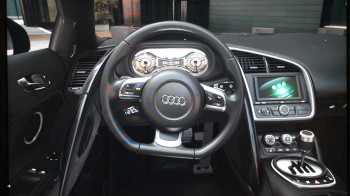
Could NVIDIA Automotive help Android shake up an entire industry?
Imagine your car dashboard.
Now imagine using your computer or smartphone to customize everything about it.
This is just the tip of the iceberg – more below – but listen to NVIDIA’s CEO discuss changes coming to a car driven by you in the near future:
That’s just the surface of NVIDIA’s innovation plans for the automotive industry. The above is called “Project Mercury” and allows automotive manufacturers to adjust, iterate, and offer live views of their cars incorporating an infinite number of colors, textures, and designs. Soon, NVIDIA hopes, your dashboard will be a lively canvas that looks and function more like your smartphone home screen: completely customizable.
The start of a new Automotive Era?
For years I’ve been trumpeting Android’s movement and eventual ubiquity in industries beyond mobile, but similar to mobile. Industries that had iterative advancements but whose oligopoly prevented dramatic improvements across the board. The two industries with the most potential: television and automotive.
Television’s technological renaissance may be a couple years away with so many licensing issues and vested interests creating an environment toxic to collaboration. Say what you want, but there isn’t a Steve Jobs around to pull off the impossible music-to-iTunes counterpart for the television industry. The auto industry, on the other hand, is chomping at the bit for more bytes.
Just as Google announced the Open Handset Alliance en route to revolutionizing the mobile industry, they’ve just announced the Open Automotive Alliance which could likely be the catalyst for a similar revolution seen in vehicles around the world. The founding members of that alliance are Audi, GM, Honda, Hyundai, and NVIDIA.
You might not know it but NVIDIA has been a player in the automotive industry for years and not just because they seem to lug bad ass sports cars to almost every major technology show on the planet (CES, MWC, etc… ). This year, though, NVIDIA is making some pivotal adjustments and announcements to make their presence in the Open Automotive Alliance well known.
The Real Smart Car: Advanced Driver Assistance
We’ve known for years now that Google is working on self driving cars; they’ve even been spotted in the wild. How in the heck does this technology actually work? You can guarantee that there is a whole lot going on in the background, and my guess – almost anonymously confirmed with announcement of the OAA launch partners – is that NVIDIA technology has a hand in it.
You know how your smartphone and camera offer live face recognition while recording video, following your subject around like white on rice? NVIDIA’s Advanced Driver Assistance technology does exactly that but instead of following faces, follows vehicles, obstacles, road signs, and more. Take a glimpse of it in action.
Don’t worry: this isn’t video you would be following live on your car dashboard. This is a reference design allowing automotive partners to track the various algorithms and see them in action. They use this to build the systems that eventually become Advanced Driver Assistance services, for example automatically initiating the brakes when a vehicle in front of you slams on theirs. Or perhaps noting the speed limit on a road sign has changed and automatically adjusting your cruise control to compensate.
Where is Automotive Tech headed?
We aren’t exactly flying around in Deloreans, or even getting driven around with google robot butlers (robutlers? anyone?), but automotive tech is poised to see strong leaps and growth in the coming 3 years. Much of that will be based on the announcements and changes happening this year. Watch the NVIDIA CEO discuss his company’s position on those changes and stay tuned to Phandroid for much in Android automotive from CES 2014.
How would you feel about having Android prevalent in your next vehicle?